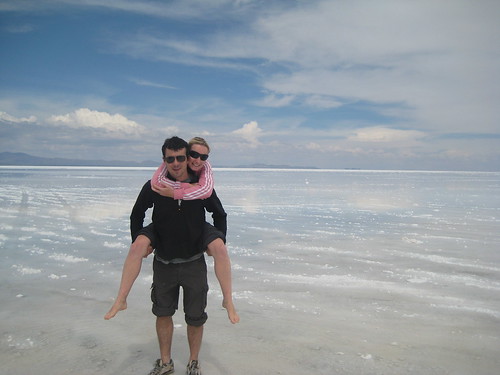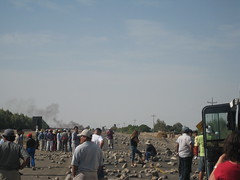 Tuesday - Friday, 19 - 22 February 2008
Tuesday - Friday, 19 - 22 February 2008 We get a collectivo the next morning from Tacna bus station. Our fellow passengers are Matt, Brenda and Morgan, a friendly American family who are just after passing over to Peru from Chile. They are now doubling-back on themselves, having learned at the eleventh hour from their tour company that their package tour to Macchu Pichu has been cancelled due to protests around Cuzco, in central Peru. They are understandably disappointed. We are supposed to be doing the Inca Trail in two weeks time, back in Peru, so are wondering now whether this will happen.
The city on the other side of the border in Chile is Arica. On the basis of the malls and chic pedestrian shopping stretches in the city centre, the average Chileno seems to be alot better off than his Peruvian cousin. We find the Gustav Eiffel designed church in the centre of town and catch up on emails. We can't find anything on the English-language internet about the disruptions in Peru. We bump into Matt, our fantastic Canadian interpretor from the previous day, and have a few cervecas with him before catching the overnight bus to Calama, about 10 hours south of Arica. Although the bus is comfortable, baggage checks with no obvious purpose in the middle of the night by Chilean officials and the bus steward's insistence on playing back-to-back martial arts movies until the wee hours (including a real gem in which Jean Claude Van Damme is cloned to help a US cop chase down the original JCVD who is a psycho-killer - a real mystery as to why this didn't win a Palme D'Or) do not make for a restful night's sleep.
We spend a few hours the following morning in Calama, which looks a lot less well-off than Arica, having the feeling of a mining town on the decline. We then get the bus to San Pedro de Atacama. The latter is the tourist destination in northern Chile and it shows. It's a small village with narrow unpaved streets, lined by quaint mud-walled houses and shops, no doubt producing the desired effect of a tourist's fantasy of what a South American pueblo should look like. In return for sacrificing their village to a Bunratty-makeover, the locals get the opportunity to fleece the moneyed tourists, both Chilean and foreign. Accommodation, food and tours are expensive. We are not staying too long though as the next day our plan is go on the three day tour to Uyuni in Boliva, taking in the Salar de Uyuni salt flats. The Lonely Planet sits on the fence when it comes to recommending a 4WD tour company for this. The message is that all of the companies are equally bad and that it is pot luck as to whether you get a good driver on the day. We ask at the Thaka Thaka hostel we are staying at and are told that Pamela Tours are not too bad. We talk to them and they don't seem too suspect so we hand over the US$110 per person for the tour. In a portent of what is to come, the guy behind the counter says with little conviction that our driver will be able to speak English "mas o menas" (rough translation: yes he will, more or less).
The next morning we meet our driver Daniel and a guy with an unpronounceable name beginning with "p" (let's call him Pomegranate) who helps Daniel on the tour. Sami, from France, is the only other tourist on the trip. He can speak a fair amount of Spanish. This is a blessing because Daniel's ability to speak English is more "menas" than "mas". He can't speak a word.
The border crossing out of Chile into Bolivia is a static queue for an hour before 9 o'clock followed by a choatic rush when the one bureaucrat opens his kiosk. A Frenchman behind us opines loudly about the moral deficiencies of South American queuers and then, at the first opportunity, trys to jump ahead of us.
It is all unsealed track as soon as we leave Chile. The Bolivian border crossing is very low-key. A Bolivian flag flutters above a small building in the middle of a plain. We swap our Chilean jeep for the one that is to take us on our trip for the next few days. It's a rusty battered bucket on wheels, although not significantly worse looking than any of the other tour companies' jeeps. Worringly, Daniel and Pomegranate are immediately occupied with with something underneath the bonnet of the jeep. This is a sight we are to become familiar with over the coming days. In any event, they manage to resolve whatever the problem was and the first day of the tour is quite good. We pass through desolate sand-covered plains, ranged by bare snow-capped hills. We stop off along the way at brilliantly coloured lakes - the Laguna Blanca and Laguna Verde - and the Rocas de Dali (rocks scattered on the plain, real student bedsit gallery material). As we pass each sight of interest, Daniel launches into his commentary with the preamble "Mis amigos". We cannot understand a word of it but reply in chorus like schoolkids, saying "Si" and solemnly repeating the name of the sight as he utters it. The final stop of the day is at Laguna Colorado, a beautiful red-coloured lake, the colour coming from algae and plankton that live off the minerals in the water. We are at 4278 metres in altitude and it's cold. The lodgings here live up to their reputation of being really basic and really cold. There is no heating, the toilets are bleak (plenty of unidentifiable biohazard on the floor and walls) and the beds don't so much have mattresses as unyielding wooden planks. As we are a small group, not all of the beds in our domitory are occupied so the 5 layers of thick woollen blankets that we thieve from other beds help against the cold. We meet another tour group that night, including Derek from Cork, and huddle around the table.
After a poor night's sleep, we wake to find Daniel and Pomegranate under the bonnet of the jeep. A group of men from the settlement have grouped around the jeep and look at it with the sympathy normally reserved for a terminally ill patient. Daniel seems to be an industrious mechanic and has already taken out what Derek identifies later as the alternator. Pomegranate sprints around the place as Daniel shouts orders at him. An hour into the procedure, things are looking grim. The jeep is not showing any vital signs. Daniel has the brainwave of draining battery acid from another jeep and seems to be able to get the jeep going. After this, we get our breakfast and hit the road. Daniel seems pensive as we set off and the forever-smiling Pomegranate is also a bit subdued. About 20 km into the journey, the jeep dies again. We are smack bang in the middle of nowhere. Ahead of and behind us stretches sand and mountains. There is no mobile phone coverage. A fine place to get stuck. We are also the last jeep of the tour groups to set off for the day so the chances of another jeep coming to our aid are nil. Daniel and Pomegranate think it's a great laugh and don't seem to acknowledge the lunacy of setting off into the great unknown without a roadworthy jeep. There follows an hour of different interventions - mechanical by Daniel, tour guides and group trying to push the jeep into a jump start from various angles. None of these work and we sit on the rocks beside the track while Daniel and Pomegranate chuckle to themselves about the silly fix they have got themselves into. Straight from a Hollywood movie, the sound of a jeep comes from over the hill. It's a wayward tour, which has come over from the Argentinian border. We are saved. We borrow some battery power from this jeep and then travel in convoy for the rest of the day until we reach Uyuni, our stop off for the day. Along the way the jeep breaks down a number of times. With the threat of being stranded somewhere for the night in the cold ever present, we don't enjoy the day. Eventually Daniel finds a telephone and calls the base in Uyuni to get Pamela Tours to send out a jeep to get us to our hostel for the night. No information is given to us about where or when we are getting dinner and what time the tour is to resume the next day. Three hours later, a elderly lady arrives with some dinner and rambles good-naturedly in Spanish to us. She tells us that breakfast will be ready at 8.30 am the next morning. In fact, we get it at 9.30 am. At 12 noon Daniel and Pomegranate materialise in a replacement jeep. It is no healthier looking than the last one and the brakes

don't seem to work. We head off to the Salar de Uyuni, the world's largest salt flat. It's a fine sight. It is an endless expanse of blinding white below us and blue sky above us. A word of advice: bring flip-flops to walk on the surface. Apart from the well-trodden paths to the bits where tourists like us take photos for their mantelpieces, in bare feet, it is quite sore, like badly set concrete. Despite all the drama and disappointment over the last few days, it's been worth it to see this. The jeep chuggs its way back to the mainland and breaks down along the way. While the running repairs are being done, alongside us workers brush and shovel the salt into piles for trucks. We are dropped off in Uyuni and say goodbye to Daniel and Pomegranate. We think they might have been expecting a tip but we have been a pretty sullen bunch so they are not too shocked when none is forthcoming. We don't know who would be a good company for this trip - Pamela Tours, it certainly ain't.
If you want to see photos click
here.
 Saturday to Tuesday, 23 - 26 February 2008
Saturday to Tuesday, 23 - 26 February 2008 


